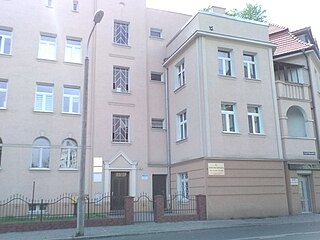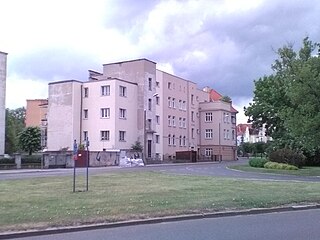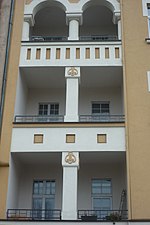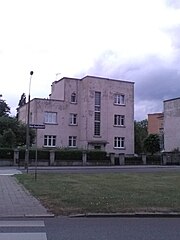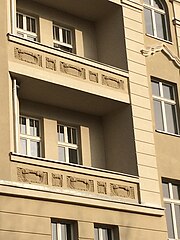| Bydgoszcz | |
|---|---|
 | |
| Native name | Plac Józefa Weyssenhoffa (Polish) |
| Former name(s) | Bülowplatz, Plac Zacisze, Johann Fichte Platz |
| Part of | Bydgoszcz Old Town district |
| Namesake | Józef Weyssenhoff |
| Owner | City of Bydgoszcz |
| Location | Bydgoszcz, Poland |
| Construction | |
| Completion | 1903 |
Józef Weyssenhoff Square is an open place in the downtown district of Bydgoszcz, Poland. Several of its buildings are registered on the Kuyavian-Pomeranian Voivodeship Heritage List.
Location
The area links Adam Mickiewicz Alley, Ossoliński Alley and Powstańców Wielkopolskich alley. Northern facades date back to the late 19th century style, while southern ones display modernist features from the first decade of the 20th century.
Naming
- 1906–1920, Bülowplatz, after Bernhard von Bülow;
- 1920–1933, Plac Zacisze ("Tranquility Square")
- 1933–1939, Plac Józefa Weyssenhoffa, after Józef Weyssenhoff, Polish writer and literary critic, who lived at Nr.1 from 1924 to 1928;
- 1939–1945, Johann Fichte Platz, after Johann Gottlieb Fichte;
- Since 1945, Plac Józefa Weyssenhoffa.
The current name refers to Józef Weyssenhoff (1860–1932), a Polish writer, novelist and poet who lived at the tenement at No. 1 in the 1920s.
History

The square was founded in 1903 in the same conditions as Adam Mickiewicz Alley. It is a triangular square from which radiated:
- Bülow straße (today Adam Mickiewicz Alley) to the north west;
- Hohenzzolernstrasse (today Ossoliński Alley to the south-east;
- in the late 1930s, Powstańców Wielkopolskich alley to the east.
In the middle was planted flowerbeds, shrubs and trees. In 1926, coniferous and deciduous trees were put. Between 1905 and 1911, a frontage of five-story apartment buildings have been built, following Art Nouveau and Historicism styles.
Architecture
Frontages of Józef Weyssenhoff Square compose a complex of townhouses inscribed in the German variant of Art Nouveau architecture (German: Jugendstil). Predominant forms evoke quietness, through varied bay windows, divided balconies and loggias integrating wavy lines, wavy gables, vaulted windows and portals. Decoration combines organic themes with geometric forms, like rectangular and square shapes, grouped in series and friezes. The ensemble reminds also Baroque style at by applying domes avant-corps and towers topped with peaks.
Some of the architects who designed those buildings had a significant influence on Bydgoszcz urbanism:
- Rudolf Kern who built also tenements in Gdańska Street at 5, 67, 66–68 and 71;
- Erich Lindenburger who constructed also at 41,43,45,47 Dworcowa Street;
- Paul Böhm who realized houses at 1 and 3 August Cieszkowski Street in Bydgoszcz;
- Józef Święcicki, known for its dozens of realization in Gdańska Street;
- Bogdan Raczkowski, designer of the Polonia Bydgoszcz Stadium and the Antoni Jurasz university hospital in the 1930s.
For almost the entire post-war period, tenements have been property of the state. In 1990, the city of Bydgoszcz owned them back, but at the time, they were falling into disrepair as a result of underinvestment, lack of maintenance and general neglect of Art Nouveau monuments. Buildings have been restored after 2002.
Main buildings
Tenement at 1 Józef Weyssenhoff Square
1905–1906, by Rudolf Kern
This is the house where Józef Weyssenhoff in from 1924 to 1928; a plaque has been placed on the facade in memoriam.
Both facades display bay windows with loggias or balconies. A richly decorated frieze runs at the bottom of the gable boasting dormers.
-
 General view of frontages
General view of frontages
-
 Detail of stuccoed motifs
Detail of stuccoed motifs
-
 Adorned door
Adorned door
-
Plaque on memoriam of J. Weyssenhoff
Tenement at 2 Józef Weyssenhoff Square
1927, by Bogdan Raczkowski
House on the border of the Sielanka district, displaying a mix of functionalist style (left side) and eclectic shapes (right side) with a loggia and Mansard roof.
Tenement at 3 Józef Weyssenhoff Square
1905–1910, by Erich Lindenburger
-
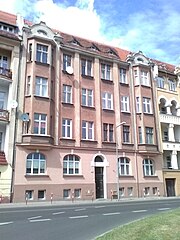 Main elevation
Main elevation
-
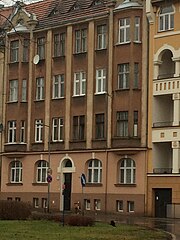 Main elevation
Main elevation
-
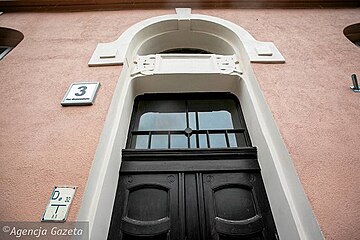 Portal detail
Portal detail
Tenement at 4 Józef Weyssenhoff Square
1933, by Eugeniusz Wellman
Functionalist edifice, abutted to Nr.2.
Tenement at 5 Józef Weyssenhoff Square
Registered on Kuyavian-Pomeranian Voivodeship heritage list, Nr.743201-Reg.A/1573 (October 29, 2010)
1908–1909, by Paul Böhm
At the beginning of the 20th century, Wiktor Weynerowski, entrepreneur and father of Antoni Weynerowski, lived there. The facade display 3 levels of balconies. The building has been recently refurbished.
House at 6 Józef Weyssenhoff Square
1934–1935, by Konstanty Dzielinski
Functionalist house, similar to buildings down Ossoliński Alley.
Tenement at 7 Józef Weyssenhoff Square
1909–1910
The facade is characterised by a balanced, even symmetry around the large arcade running above the entry gate. This round motif is recurrent through the whole frontage, from the ground level arcades up to the curved pediment.
-
 Main elevation
Main elevation
-
 Detail of the curved pediment
Detail of the curved pediment
-
Main gate portal
-
Adornement of the portal
Tenement at 9 Józef Weyssenhoff Square
Registered on Kuyavian-Pomeranian Voivodeship heritage list, Nr.725836-Reg.A/1522 (March 20, 2009)
1910–1911, by Georg Baesler
Building of the Institute of Agriculture
Main article: Institutes of agriculture of BydgoszczRegistered on Kuyavian-Pomeranian Voivodeship heritage list, Nr.601254-Reg.A/676/1-8 (May 20, 1992)
Józef Weyssenhoff Square Nr.11
1903–1906, by H. Delius
The architectural ensemble of the Institutes of Agriculture in Bydgoszcz occupies an area of 7.5 hectares, between J. Weyssenhoff Square, Ossolińsky Alley, Powstańców Wielkopolskich Alley and Karol Szymanowski Street. The western area is laid out with buildings, the eastern one is a 5 ha zone of field vegetation, with livestock, greenhouses and a barn.
-
 Institutes of Agriculture ca 1908
Institutes of Agriculture ca 1908
-
 General view from Plac J. Weyssenhoff
General view from Plac J. Weyssenhoff
-
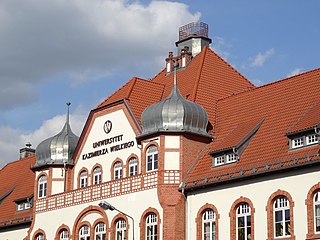 Main avant-corps with tin roof, the observatory on top
Main avant-corps with tin roof, the observatory on top
-
 Main gate
Main gate
-
 Transom light and its decorated cartouche
Transom light and its decorated cartouche
 Panoramic view of Former building of the Institute of Agriculture
Panoramic view of Former building of the Institute of Agriculture
References
- Umiński, Janusz (1996). Bydgoszcz. Przewodnik. Bydgoszcz: Regionalny Oddział PTTK. "Szlak Brdy". p. 115.
- Tandecki Janusz, Okoń Emanuel (1997). Bydgoszcz – historia i rozwój przestrzenny. Atlas historyczny miast polskich. Tom II Kujawy. Zeszyt I Bydgoszcz. Toruń: Uniwersytet Mikołaja Kopernika.
- Bromberg Map, 1939, Generalstab des Heeres
- Kuczma, Rajmund (1995). Zieleń w dawnej Bydgoszczy. Bydgoszcz: Instytut Wydawniczy "Świadectwo".
- Bręczewska-Kulesza, Daria (2007). Wielkomiejska kamienica czynszowa w Bydgoszczy na przełomie XIX i XX wieku. Materiały do dziejów kultury i sztuki Bydgoszczy i regionu. Zeszyt 12. Toruń: Pracownia Dokumentacji i Popularyzacji Zabytków Wojewódzkiego Ośrodka Kultury w Bydgoszczy.
- Bręczewska-Kulesza, Daria (2007). Wpływ architektury i architektów berlińskich na bydgoskie budownictwo mieszkaniowe na przełomie XIX i XX stulecia. Bydgoszcz: Pracownia Dokumentacji i Popularyzacji Zabytków Wojewódzkiego Ośrodka Kultury w Bydgoszczy.
- Wysocka, Agnieszka (2004). Bogdan Raczkowski – architekt i urbanista międzywojennej Bydgoszczy.Materiały do dziejow kultury i sztuki bydgoszczy i regionu zeszyt 8. Bydgoszcz: Pracownia dokumentacji i popularyzacji zabytków wojewódzkiego ośrodka kultury w Bydgoszczy. pp. 465–485.
- ^ Załącznik do uchwały Nr XXXIV/601/13 Sejmiku Województwa Kujawsko-Pomorskiego z dnia 20 maja 2013 r.
- Wysocka Agnieszka, Daria Bręczewska-Kulesza (2003). Wille na Sielance. Kronika Bydgoska Zeszyt 25 (in Polish). Bydgoszcz: Towarzystwo Miłosnikow Miasta Bydgoszczy – Bydgoskie Towarzystwo Naukowe. p. 57.
- Adressbuch nebst Allgemeinem Geschäfts-Anzeiger von Bromberg mit Vororten für das Jahr 1900 : auf Grund amtlicher und privater Unterlagen. Bromberg: A.Dittmann. 1900. p. 220.
- Derkowska – Kostkowska, Bogna (2004). o założeniu Sielanki – bydgoskiego miasta ogrodu. Materiały do dziejow kultury i sztuki bydgoszczy i regionu Zeszyt 4. Bydgoszcz: Pracownia dokumentacji i popularyzacji zabytków wojewódzkiego ośrodka kultury w Bydgoszczy. p. 84.
- Grzybowska Maria, Werterowska Zofia (1999). Przyczynki do historii architektury zespołu naukowych Instytutów Rolniczych w Bydgoszczy. Bydgoszcz: Pracownia Dokumentacji i Popularyzacji Zabytków Wojewódzkiego Ośrodka Kultury w Bydgoszczy. p. 60.
External links
Bibliography
- Bręczewska-Kulesza, Daria. Przegląd stylów występujących w bydgoskiej architekturze drugiej połowy XIX i początku XX stulecia (in Polish). Bydgoszcz.
- Jastrzębska-Puzowska, Iwona (2005). Od miasteczka do metropolii. Rozwój architektoniczny i urbanistyczny Bydgoszczy w latach 1850–1920 (in Polish). Toruń: Wydawnictwo MADO. ISBN 83-89886-38-3.
- Umiński, Janusz (1996). Bydgoszcz. Przewodnik (in Polish). Bydgoszcz: Regionalny Oddział PTTK. "Szlak Brdy".
- Czachorowski, Antoni (1997). Atlas historyczny miast polskich. Tom II Kujawy. Zeszyt 1. Bydgoszcz (in Polish). Toruń: Uniwersytet Mikołaja Kopernika.
- Kuczma, Rajmund (1995). AZieleń w dawnej Bydgoszczy (in Polish). Bydgoszcz: Instytut Wydawniczy "Świadectwo".
53°07′53″N 18°00′43″E / 53.1313°N 18.0120°E / 53.1313; 18.0120
Categories:
